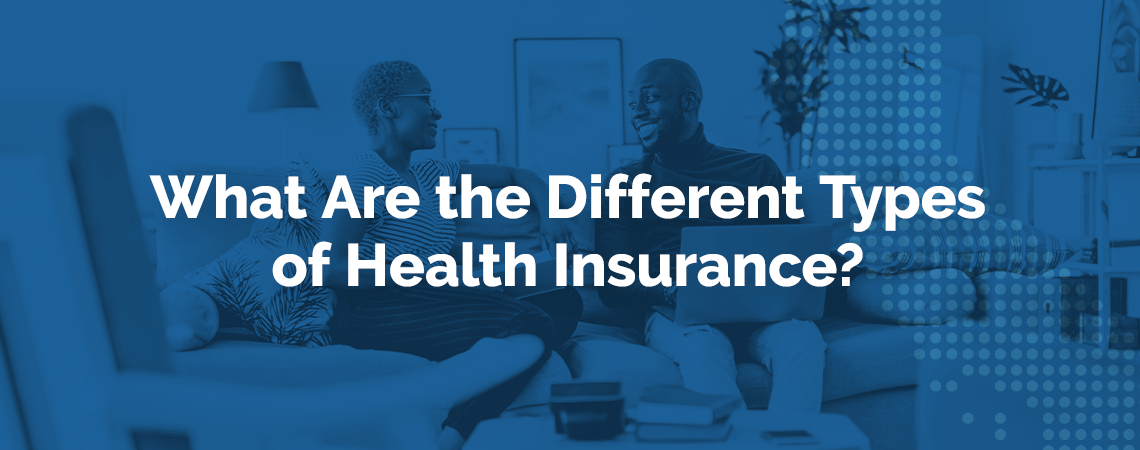What Are the Different Types of Health Insurance?
Posted: August 16, 2023

What Are the Different Types of Health Insurance?
Navigating types of health insurance in the U.S. can be challenging. Some plans offer low deductibles and limited coverage, while others are more flexible but require higher premiums. Explore the five main types of health insurance, other options you might take advantage of and where you can search for new plans.
What Are the 5 Types of Health Insurance?
Examples of health plans in the United States fall into five categories — HMOs, EPOs, POSs, HDHP and PPOs. Explore each type to determine what might fit your needs.
1. Health Maintenance Organization
A health maintenance organization offers care from doctors, providers and hospitals within your plan’s network. You must get referrals from your primary, in-network care physician before seeing a specialist or outside health care provider. This insurance plan may not cover services without a referral, leaving you responsible for out-of-pocket costs.
Some advantages of HMOs include the following.
- Low payments: You’ll pay less each month and in out-of-pocket costs.
- More prevention: HMOs promote wellness and prevention with classes, education and fitness memberships.
- Less paperwork: Each visit and referral requires less paperwork.
Here are some disadvantages of HMOs.
- Less flexible: It may be harder to find doctors or facilities where you can seek care.
- No outside care: Visiting out-of-network providers requires extra costs and referrals.
- Need referrals: You always need referrals for specialist visits.
2. Exclusive Provider Organization
An exclusive provider organization uses in-network doctors except during emergencies. Each EPO member has a primary care provider who offers referrals to in-network doctors and specialists. Members pay smaller copayments and deductibles depending on the plan type.
Some advantages of an EPO plan include the following.
- Lower rates: You have lower rates on all your plan types.
- A limited pool of providers: Searching for medical providers won’t take you long.
The potential downsides of an EPO are as follows.
- Fewer provider choices: You will have fewer options for providers, doctors and specialists.
- Higher costs: Medical emergencies will cost you more.
3. Point of Service
A point-of-service plan includes the services of HMO and PPO plans. Point-of-service plans require members to choose a primary care provider through in-network options. Often, benefits through the PCP don’t apply to the policy deductible.

Members who use services through their PCP obtain high amounts of medical coverage. However, if they visit out-of-network providers, they may have to pay a deductible or receive less coverage. In some cases, you may have to pay for costs upfront and submit claims for reimbursement.
Potential benefits of a POS plan include the following.
- Flexibility: You can easily choose between physicians, doctors and providers.
- Designated care: PCPs will choose medical care for you and coordinate with providers.
- More choices: You’ll have many providers to choose from.
You’ll also need to consider some downsides of a POS plan.
- Care decided for you: Your primary care physician coordinates all the care.
- High insurance premiums: The point of service often results in higher insurance premiums.
4. High-Deductible Health Plan
A high-deductible health plan requires qualification through the IRS, where plans have deductibles equal to or higher than $1,350 for individuals and $2,700 for families.
Some advantages of a high-deductible health plan include the following.
- Low monthly payments: You’ll pay lower monthly fees.
- High savings: You can save money if you are healthy and rarely need to visit a doctor.
Possible drawbacks of high-deductible plans are as follows.
- High out-of-pocket costs: Because monthly payments are lower, you’ll have to pay more until you meet your deductible if you get sick or have a medical emergency.
- HSA required: You must sign up with a health savings account to cover expenses. Pre-tax dollars fund the HSA account and act as an investment past retirement.
5. Preferred Provider Organization
Preferred provider organization health plans are standard. Employers often offer these, where members can use in-network doctors, hospitals and providers to receive care at a set or discounted rate. You don’t need a primary care provider, and you can see any doctor in the network.
Members must usually meet a yearly deductible before their plans cover medical expenses. You’ll also have a copayment for specific services or co-insurance for a percentage of total fees. If you want to see a physician outside your network, you will be responsible for higher costs and expenses.
Here are some reasons many people prefer having a PPO plan.
- Freedom and flexibility: You can choose your primary care physician and any health care facility as long as it’s in your network.
- Outside costs covered: Your plan will cover some out-of-network costs.
- Specialists without referrals: You can see a specialist without a referral from your primary care doctor.
Some disadvantages of a PPO plan include the following.
- Higher premiums: You will pay higher monthly premiums depending on the type of plan your employer offers.
- Deductibles: Members must pay an out-of-pocket deductible before their insurance covers anything.
Choose a Health Plan With Help From Health for California
Health for California is a statewide health insurance agency. Since 2004, we have helped Californians find and apply for health coverage. We’ll pair you with an agent licensed by Covered California and the California Department of Insurance to find you the best possible plan.
We’ll start by offering a quick quote and then move on to recommend coverage that meets your specific needs. If you have questions about the most common types of insurance in the United States and what plans are available in California, we are here for you. Our agents can help you compare plans and apply for a policy based on your medical conditions and wellness requirements. We also provide other services, such as calculating government subsidies and considering cost-sharing qualifications. Contact us today to speak to a representative or shop for different plans online.
